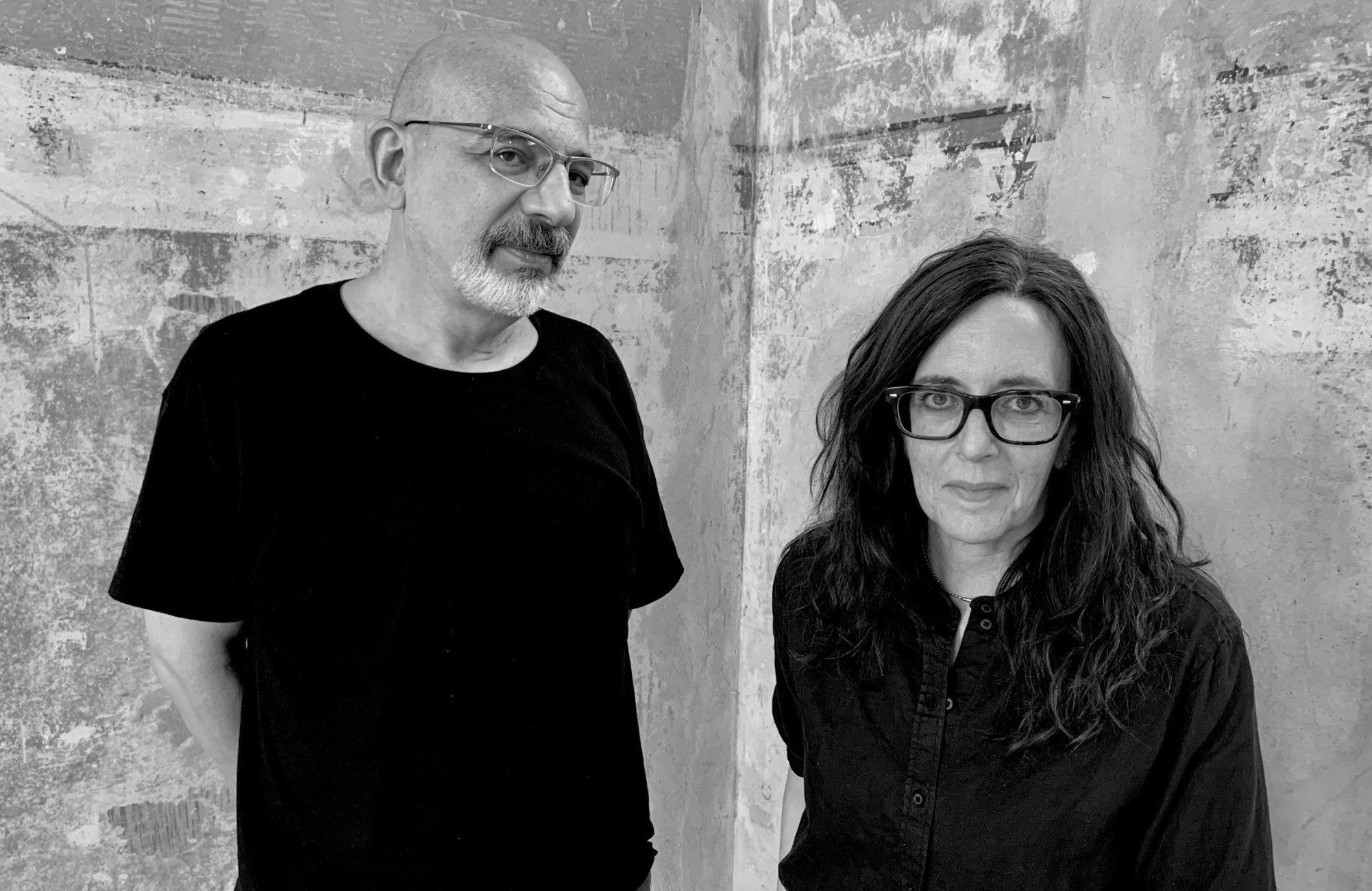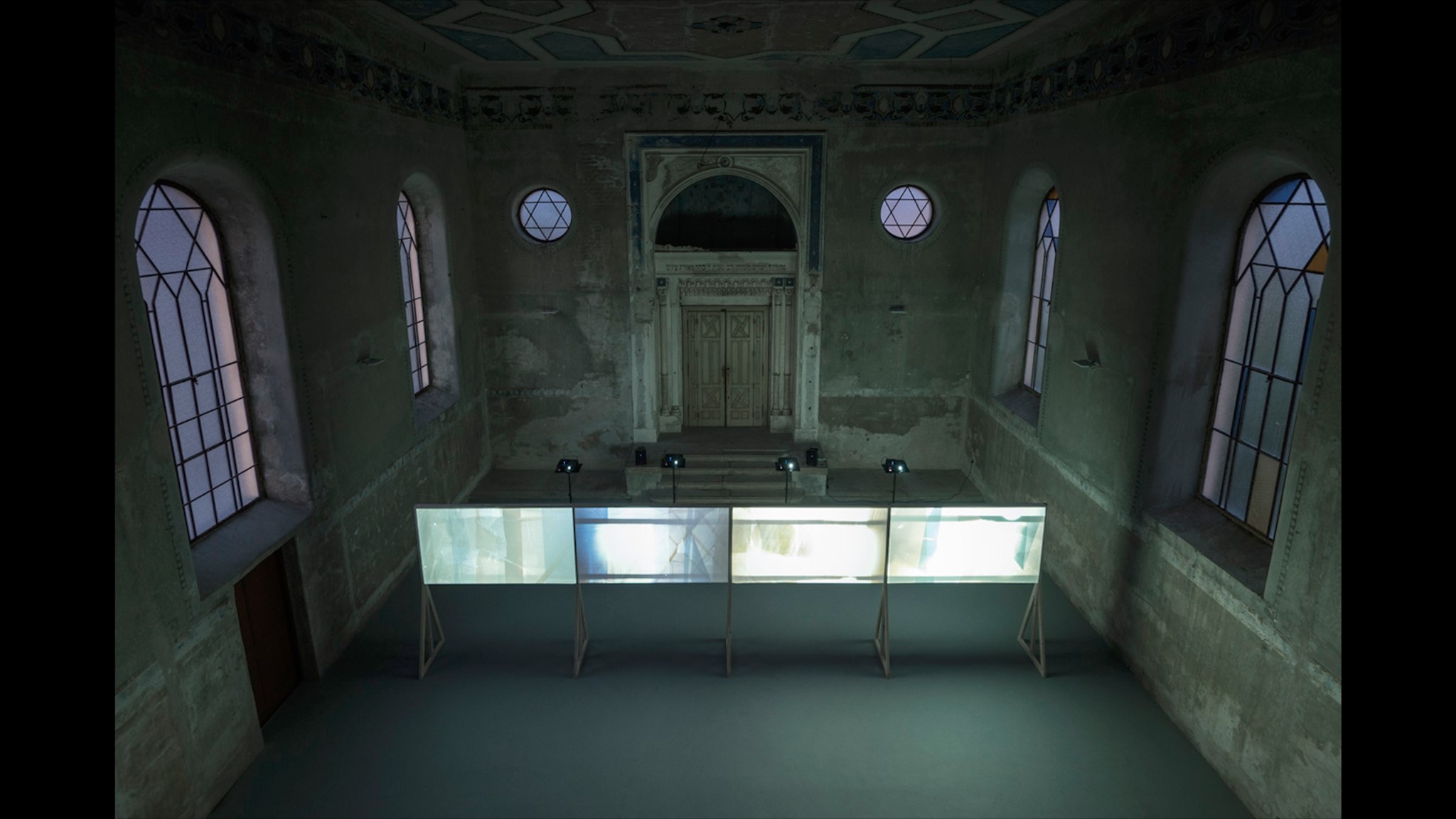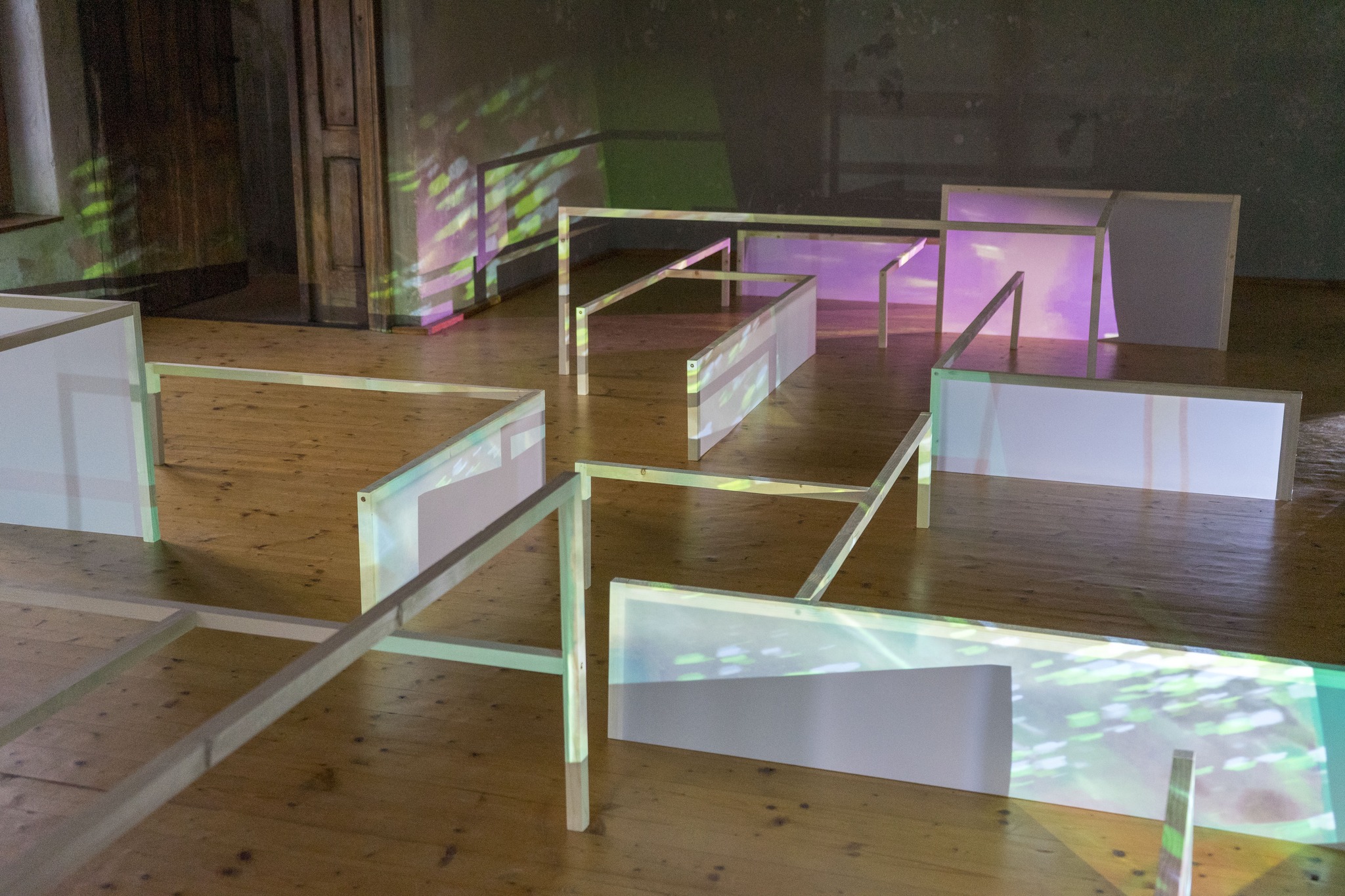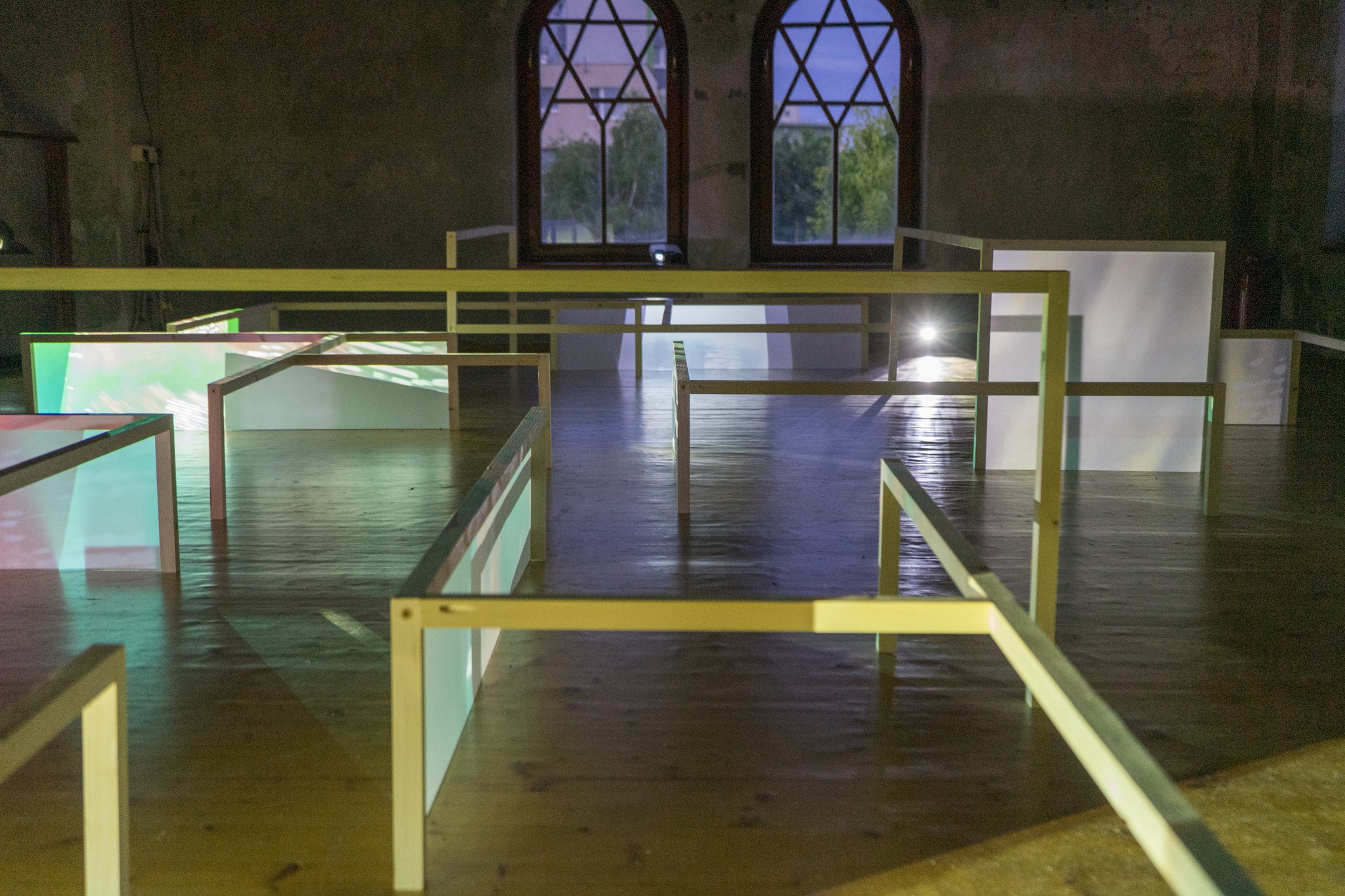
Unravelling the Resonances of Memory
Sheri Wills and John Schettino work with abstract imagery in order to explore what remains unseen in photorealistic images: their psychological and philosophical dimensions. We talked about their approach to abstraction and how memory and space materialize in their work—especially in the two video and sound installations they designed for the synagogue in Šamorín, which functions as the exhibition space of the At Home Gallery.
This summer the two New York-based visual artists participated in At Home’s artist residency program. However, the story of their cooperation with the gallery began years ago. Sheri was exploring exhibition opportunities and residency programs in Central Europe — she was interested in the region because her family had come from here — when she came across Suzanne and Csaba Kiss’s gallery based in an unusual space, a former synagogue. Following Sheri’s 2018 exhibition, titled “What Does Light Remember?”, she designed another piece for the gallery in 2020, this time as a collaboration with John Schettino. At that time — the height of the pandemic — the artists could not travel to Europe, so Assembly, a site-specific video and sound installation, was installed by the gallery owners. The artists came to Šamorín this summer and installed the piece again, as well as a new one, which was developed as the second part of the series. Building with the same materials and ideas, they installed the complementary piece on the first floor of the synagogue. Unlike the original piece, the one upstairs was designed in three-dimensions, welcoming visitors to walk through the installation.
Sheri Wills creates sound and video installations, as well as live video performances. She works with film, video, and sound. She teaches at the Rhode Island School of Design, and she is a recipient of the 2023 Guggenheim Fellowship.
John Schettino creates sculptures, drawings, and digital media artworks. His work often explores place, space and landscape, and he is particularly interested in the problems of human geography.

You use video — the medium we tend to associate with direct representation of reality — for creating abstract work. Can you elaborate on how you perceive the relation between video and abstraction?
Sheri Wills: I am not very narratively oriented: I work with associations and think about imagery in a non-narrative way. I really like to work with lensless imagery; I just take a strip of film, put objects on top of it and flash it with light. Even though this method is actually direct representation — with the actual object on the film, it’s just like a photograph — when you play it back, it becomes abstract. That is really interesting to me because it challenges our ideas of what realistic imagery is. Even when I shoot with a camera, it’s always about looking at it in a different way, which I feel is more realistic to my experience than a photorealistic image.
John Wills: We both have been working abstractly for most of our adult lives, and one of the things that I feel interested in is the question of what representation is. For the last 500 years, we’ve been locked into a very specific understanding of it. I’m really interested in pre-Renaissance art, the time right before the development of perspective. With the development of perspective, describing and thinking about how something is represented became very codified and structured. I think that the way Sheri and I think about representation goes all the way back to that. While broadly available commercial film, for example Hollywood cinema, is about making something to look as real as possible, one of the big questions for us is to decide what is the thing that we are trying to make real. Is it just an optical illusion, an optical simulation? Or is there something more than just what an object looks like when light hits it? We both would say there’s a lot more going on than just light hitting a surface, which looks a certain way. And when you look at a Vermeer, even in a very real, realistic representational painting there are a lot of layers to unfold. What we’re interested in is less about the person in the painting than about what is happening around them that creates and prompts the things that you respond to emotionally and intellectually.
Sheri Wills: Exactly. And just to build on the Renaissance idea of linear perspective: it trains us to see in a certain way. That is what film and cinema have really done. I have dreams where what I’m seeing is like an over-the-shoulder kind of shot. Another interesting technique is a smooth pan: actually, you can’t do a smooth pan with your eyes. We just think we can because the camera does and we’ve seen that so many times. To me, it’s about questioning our assumptions about how we see and how we interpret.
John Schettino: Among the many things that we’ve both been interested in is pre-cinematic experiences. Even in the history of painting and still images, there was at the beginning a real impulse towards capturing inaccurate representation. In the early moments of cinema, there are lot of attempts using different kinds of technologies and techniques to create experiences that replicated the experience of being in the world. Like panoramas, where you could walk into a room and be completely surrounded by an image. There’s also a tradition of early landscape painting, where the painter created the impression that you are inside the landscape, inside the painting. But even when you create a context that is immersive and surrounding, there’s always a gap, right? And the gap is the person who’s having the experience. That gap suggests an opening — it’s the opening that we try to aim for and draw from to find opportunities for the things you still experience, but which may not have exact optical representations. That gap in technology and in our perception is the place we’re trying to draw from in the work that we make.

The central focus of Assembly I and II is memory — and we can talk about the concept of memory in relation to the pieces on at least two levels. On one hand, their content has to do with personal memories. On the other, there is a tribute to an artistic tradition as the sound follows the structure of Alvin Lucier’s well-known sound art piece, which consists of a tape recording that is being played and rerecorded again and again, until the recorded sound is destroyed by the resonant frequencies of the room. Why is that experimental work from the ’60s important for you today?
Sheri Wills: I think we’re both interested in creating work that doesn’t just exist in one moment of time but which is part of a continuum. I was showing Lucier’s piece I’m Sitting In A Room to my students in the spring of 2020. It’s a long piece and some people respond to it, some people don’t. We had a really energetic discussion about it and it made me feel very interested in being part of that tradition. It’s like following a recipe in the way that you record and rerecord and rerecord, but Alvin Lucier was really interested in a certain set of questions that was particularly important to him and to the experimental composers of the ’60s. The sound I used had been recorded in this space in the spring of 2018. (Editor’s note: It was a recording of Juraj Turtev and Marta Galbáčová’s song that they performed during the opening of Sheri’s installation). And then I rerecorded it in my studio in New York over and over again without trying to create a perfect studio environment but by incorporating the surrounding sounds: the metal window created a shimmering sound, and at one point a motorcycle went by outside. As these artifacts of certain times and places get woven in, it becomes something entirely different.
And it was around the time that Alvin Lucier died.
Sheri Wills: And so all of a sudden, everyone was recreating his works and doing performances of I Am Sitting In A Room. So, it became a real part of that moment. I think the piece would work even if you didn’t know anything about how it was connected to avant-garde music history, but I really want people to know that that’s a part of this piece. Bringing that tradition here now is a wonderful thing.
John Schettino: And beyond the technical question of what happens to the recording over time, when you rerecord it over and over again, what you had really been focusing on for a while when you were developing ideas for the piece was the way that that experience of the sound also parallels the way memory works. The rerecording and rehearing of a sound are like remembering. The further away you get from the original experience and the more you remember it, memory can change. And sometimes it becomes very different from the original experience.
Sheri Wills: We don’t fully understand how the brain works, but the prominent theory is that every time we call up a memory, we replace the actual memory with our memory of the memory. So that’s why memory is so fallible. Every time you remember, you’re actually replacing the last memory with your current memory of that memory. That is very much like a generational decay with the Xerox copy machine or with sound.
John Schettino: I think that’s embedded in the overall experience that we’ve been trying to evoke here. It’s a kind of reconciling with the idea that things are constantly shifting our understanding and experience of things. It can be very hard to pin something down or define it very precisely. The pieces are designed to be experienced throughout the day, so one thing that happens is that the light changes: it’s one experience at one time of the day, later in the day it’s different. Then there are lot of angles to it as you move around it. It is like constantly being in motion in time and space, and in the space of our memory with all of these different kinds of glimpses. How does that all get pieced together? How do we understand something? It points to the idea that there’s rarely a fixed perspective or fixed understanding. Things are very rarely set in stone. They are often a lot fuzzier, slippery, and mobile than they appear to be.

Sheri Wills – John Schettino: Assembly II., Šamorín, At Home Gallery (photo: courtesy of Sheri Wills)
John, in your work you tend to focus on space and questions related to landscape. How do you perceive the space of the synagogue in relation to your other works, and in relation to how you usually think about space?
John: The synagogue’s visible weathered surfaces give us a sense of layers of time: when you look at the walls, it really feels like there’s layers of history on those walls. In my own work, I don’t normally think about time that much, as I’m usually more focused on how we see and understand landscape and the ways it comes into existence. When we worked on Assembly I, one of the things we’ve tried to think about is how to create a two-dimensional landscape. Upstairs, in the complementary piece, we created a three-dimensional landscape, that you can walk through. Upstairs and downstairs relate to each other, although it’s two very different ways of thinking about how we experience and are in our own environments.
Sheri Wills: John’s interest in this space comes out in everything, like the design of the images for the screens. When looking at the installation, a lot of people think that the shapes of the walls in the video projection are actually the walls of the synagogue — however, he photographed them in New York while walking around the city. They really resonate with the texture of the walls here.
John Schettino: The question might also concern our relationship with the space. What’s our relation to the space and why? One of the challenges of this piece was to work in a way that respects the space. How does my art work in this space?
Sheri: To me, it’s really important to not be hierarchical in terms of regarding the work as somehow central. That is one reason why I would never like to darken the windows, because what’s already here is just as important as what we’re bringing here.
John: And one of the really big challenges is that we’re coming from the outside. We’re not Slovakian, not Jewish, we don’t even live in Europe. We’re New Yorkers and we have a really different set of experiences and a different history to anything in this space or this surrounding area. So, when thinking about this space, one of the big questions is how do we, as outsiders, try to understand it: how to work here without making it our story? How to respect the space and its history?
Proofreader: Martha Kicsiny
Cover photo: Sheri Wills and John Schettino (photo: courtesy of Andrej Bán)
